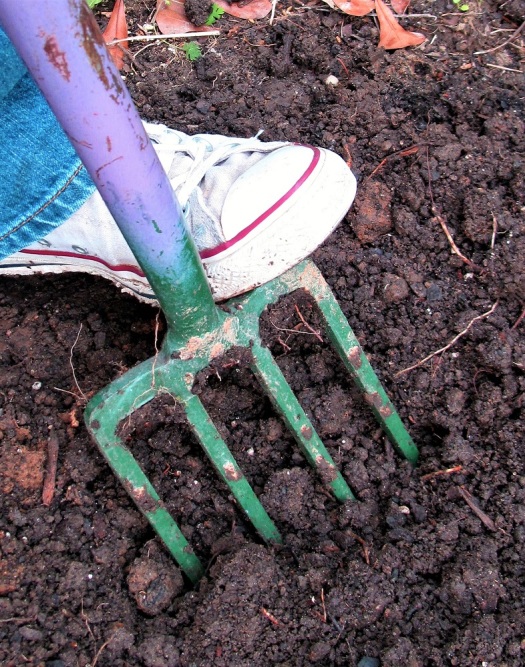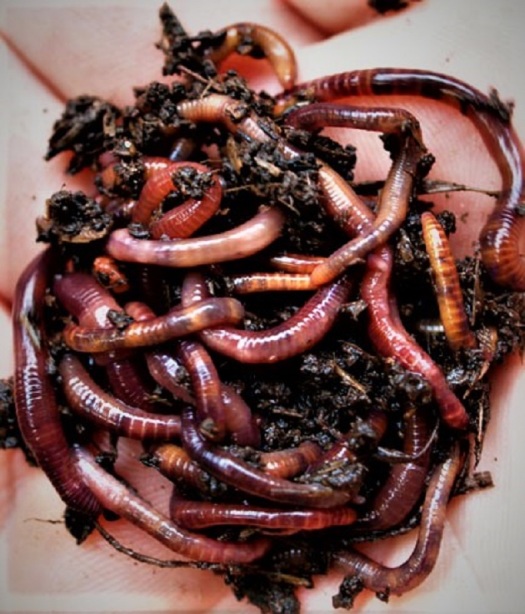There be monsters underfoot.

While checking on my garden’s rainfall drainage patterns during a recent downpour, I caught one of the longest worms I have ever seen as it ventured out of a sodden raised bed. When I tried to gently tug the foot-long creature out of the soil, it resisted, clinging, alarmed, to the sides of its burrow with tiny, claw-like bristles similar to those that so swiftly propel “graboids” (Caederus mexicana, the twenty-foot long terrors of the Mojave Desert).
Wasn’t a whopper like those I’ve seen in photos from China and Australia, but it was still a monster, living fat and happy in soil that only last year was unimproved, concrete-hard clay.
Though this post could be seen as such by uncharitable folk who don’t celebrate unexpected wonders, I’m not bragging here – though all good gardeners gleam a little inside when they come across real doozies – the bellwethers of great soil.
In case you may suffer from vermiphobia, I won’t bleat nit-pickedly about the worm’s species (yeah, I do know), or get into earthworm lore (there’s lots, including from Charles Darwin). Epigeic, endogeic, anecic – not important here. No squeamish memories from biology class earthworm dissections, or how they are both-sex hermaphroditic.
Not gonna delve into how most of the big worms in my part of the world are forest-destroying invasive species, or share the pros and ghastly cons I’ve learned from using each kind of worm as fishing bait.
Won’t share my favorite worm recipe, from the annual California contest. Don’t hold your nose if you eat mushrooms or liver, both of which are disgusting to me. Besides, worms are high protein and low cholesterol – just what the doctors order.
And I won’t gloss over how the common small “earth” snakes in my garden are about the same dimensions as worms. Only with eyes.

Which is the real worm?
Oh, and though I am a huge fan of esoteric festivals and a proud owner of a set of Morris dancer bells, I can’t with a straight face describe “worm charming” but it’s a Googleable thing, with competitions From Texas and Florida to Devon, England.
Just want to share a little bit about the three kinds of earthworms that delight me the most in my garden.
Red Wrigglers

The hardest workers are my “girls” – the little tropical “red wrigglers” I’ve kept by the dozens in a plastic indoor “vermicompost” box, where they turn old newspapers and kitchen scraps into black gold (note: they sometimes have trouble digesting the editorial section of the paper). The shallow leaf-litter dwellers are so voracious they would starve in regular dirt, and freeze in the winter. There is lots online about this, but my simple approach can be found by clicking here.

Green Worm
The second, a curious creature I find only when digging deep or in the first turnings of heavy soil for new beds or shrub holes, is the muddy greenish-yellow worm called the “green worm” (love its Latin name: Allobophora chlorotica). It’s a soil-eating worm that makes sideways tunnels deep in heavy soil; it curls up into a tight spiral when handled, which you will only do once after discovering how difficult it is to wash off its oily, intensely musky excretions. As kids, we called them “stink bait” and prized them for catching catfish.

Night Crawlers
But the big ones, the large “night crawlers” that come out at night and after heavy rains, are the best. They deposit plant-ready nutrients as they migrate up and down between soil layers, creating long-lasting vertical burrows which aerate and drain my clay.

These worms are especially good for where my own piddling around with a turning fork isn’t easy. I discovered years ago that by simply spreading leaf litter over the clay, and dusting it lightly with nitrogen- and protein-rich cottonseed meal – essentially feeding the worms – the small, pinkish anemic-looking wormlets become beefy mini-monsters that transform my dirt into soil.
Getting back to the big ‘un I found that rainy day, as I held it for a moment, calming us both ’til it stopped flipping and flopping around, I felt as proud as a rancher who helped a calf grow into a prize cow.
But, like any good worm wrangler, I let it go, putting it back to work in the moist soil. And I made a mental note that this bed won’t have to be dug ever again. Just feed the worms.

Oh, one last anecdote. My horticulturist friend Gail Barton and I once discussed whether it would be better for a worm to be hit with a sharp or a dull shovel. I mean, to a point, most worms can regenerate into two new worms when cut.
“I’d rather be hit with a dull shovel,” Gail mused, “so there’d be at least half a chance for a smooth ride to the bottom of the hole.”

Those are big fat worms. Really cute little snake.
LikeLike
I have a lot of those fat worms in our backyard. I know in the Spring the birds have a feast!
LikeLike
I can surely tell the difference between a snake and a worm. Sorry, they both give me the creeps.
LikeLike
Do you remember ‘How To Eat Fried Worms’ by Thomas Rockwell? I don’t. I just remember that it was something that our schoolteachers read to us from when we were little kids. Those little salamanders that I find in rotting wood remind me of it more than actual worms do.
LikeLike
Yeah, there used to be an annual earthworm recipe contest in CA…my favorite was worm quiche…
LikeLiked by 1 person
I could never eat one of my worms, I kiss them, hug them, squeeze them, spank them & call them george! Kidding aside worms are helping me turn my hill of clay into gardening space one small bed at a time. I once found an adorable earth snake in my compost heap & was charmed with how cute it was. My neighbor stopped by while I was handling it & I thought his young son would appreciate seeing the tiny snake, but was I wrong! The father was not at all thrilled & told me for all I knew I could be handling a baby rattler even though i had my trusty field guide in hand. He strongly encouraged me to drop & stomp it (as if) just because it was a snake but with an air kiss I released the little guy back into compost so it could continue living its happy little snake life. That was a few years back so thanks for reminding me of my happy find, it was first & only time I’ve ever seen a rough earth snake.
LikeLike
Love my “girls” too! Sad, though, how some folks are so knee-jerk about snakes and other harmless but beneficial wildlife…
LikeLike